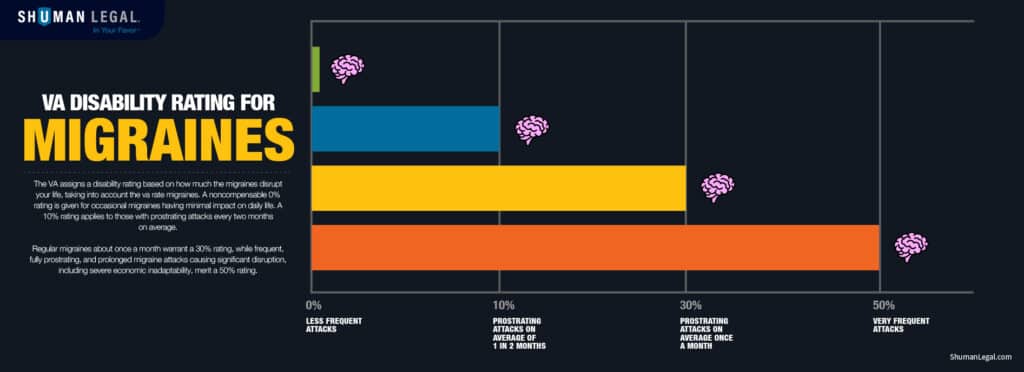Key Takeaways
- VA disability for migraines is rated from 0 to 50 percent based on attack frequency and severity, and thorough documentation of each attack can strengthen a claim.
- Veterans can potentially increase their migraine disability rating by documenting new symptoms and the impact on daily life, and by connecting migraines to service-related conditions.
- Pursuing TDIU may be a viable option for veterans whose migraines prevent gainful employment, but they must establish a service connection and present comprehensive medical evidence and testimonies.
Your search for help ends here. Let’s get started, for FREE.
Understanding VA Disability Ratings for Migraine Headaches
When it comes to VA disability benefits, knowledge is power. The VA rates migraine headaches based on the severity and frequency of attacks, considering their impact on a veteran’s life and employability, with possible ratings of 0, 10, 30, and 50 percent. A prostrating migraine, one which necessitates lying down in a dark room, is used by the VA as an indicator of attack severity.
Understanding the VA’s rating criteria for migraines is essential for preparing a disability claim. The lack of a specific duration for a migraine to be considered ‘prolonged’ according to VA standards introduces a level of subjectivity in determining higher disability ratings. This is why it is so crucial to understand the criteria and to document your condition thoroughly.
The Criteria for a 0% to 50% Rating
The VA assigns a disability rating based on how much the migraines disrupt your life, taking into account the va rate migraines. A noncompensable 0% rating is given for occasional migraines having minimal impact on daily life. A 10% rating applies to those with prostrating attacks every two months on average.
Regular migraines about once a month warrant a 30% rating, while frequent, fully prostrating, and prolonged migraine attacks causing significant disruption, including severe economic inadaptability, merit a 50% rating.
Identifying a Prostrating Migraine
What exactly is a ‘prostrating’ migraine? The VA defines a prostrating migraine as an attack that is severe enough to necessitate the individual to rest or lie down for symptom management. So, if your migraines force you into a dark, quiet room, you’re likely experiencing prostrating migraine headaches.
Recognizing this can be a crucial step towards receiving the disability benefits you deserve.
Documenting Migraine Frequency and Intensity
When it comes to VA disability claims, details matter. Veterans should meticulously document every migraine attack, noting down each occurrence along with specifics. The records should encompass the dates of migraine episodes, their duration, and intensity, as well as any work absences or doctor visits.
Equally important is your personal statement. A compelling personal statement that describes the frequency and severity of migraines and how they affect your daily activities can significantly support your claim. Your personal story can make the difference in securing the VA rating you deserve.
Strategies for Increasing Your Migraine Disability Rating
While dealing with migraines is challenging, there are strategies you can employ to increase your VA disability rating. One strategy is documenting any new symptoms or increased disruption to your routine, which can support your case for a higher rating. Tracking the increase in frequency or duration of migraine attacks serves as substantive evidence to justify a higher disability rating.
In addition to your own records, consider gathering testimonials. Testimonies from employers, colleagues, and family members can elucidate the impact of migraines on your daily functioning and employability. For veterans whose migraines prevent maintaining substantially gainful employment, pursuing Total Disability Individual Unemployability (TDIU) can be a strategic approach.

Leveraging Secondary Conditions
Migraines in veterans can stem from a variety of service-related causes such as:
- Depression
- PTSD
- Traumatic brain injury (TBI)
- Spinal injury
- Eye injury
When migraines are linked to other service-related conditions, they can be rated by the VA as a secondary condition, influencing the veteran’s overall disability rating.
Secondary conditions, like depression or insomnia, can develop due to migraines, which has the potential to elevate a veteran’s comprehensive VA disability rating. Therefore, it’s important to consider the full picture of your health when making your VA disability claim.
Pursuing TDIU for Severe Migraine Cases
Total Disability Based on Individual Unemployability (TDIU) represents VA benefits at a 100% rating designated for veterans who cannot maintain substantially gainful employment due to their service-connected disabilities. If your migraines are so severe that they prevent you from working, TDIU may be an option for you.
To pursue a TDIU benefit claim, veterans should provide medical evidence and documentation substantiating that migraines or their combination with other disabilities prevent them from working. If you’re unable to maintain consistent employment due to frequent work absences, you may meet the TDIU criteria.
Were You Denied Veteran Benefits?
Navigating the Service Connection for Migraine Claims
The path to successful migraine-related VA claims is often frought with challenges. For a start, veterans may experience migraines due to traumatic brain injuries, concussions, neck injuries, or exposure to toxic chemicals during their service. Establishing a service connection for migraines involves a thorough medical diagnosis, documenting symptoms, identifying patterns over time, and potentially linking migraines to a service-related incident or condition through a medical nexus.
Despite these challenges, a Compensation & Pension (C&P) exam may be required to evaluate the connection between the veteran’s migraines and their military service, which is conducted by the VA or a contracted provider at no cost to the veteran. Legal assistance from a VA disability lawyer can be critical for veterans with severe migraines, cases of misdiagnosis, or when there is difficulty in establishing a direct service connection.
Direct Service Connection: Combat and Non-Combat Causes
Establishing a direct service connection for migraines requires distinguishing between migraines caused by combat stressors and those arising from other service-related duties. Combat-related stressors triggering migraines can include exposure to explosives and loud noises prevalent in combat zones.
Conversely, non-combat causes of service-related migraines can involve exposure to environmental hazards like burn pits and chemical solvents.
Gathering and Presenting Medical Nexus Opinion
A medical nexus opinion is a critical piece of evidence for demonstrating the link between migraines and military service when applying for VA disability benefits. Obtaining a medical nexus opinion often involves consulting a neurologist to provide a professional diagnosis that supports the connection between migraines and military service.
To establish a direct service connection, it may be necessary to present evidence of in-service events that could have contributed to or triggered service connected migraines, which would require a migraine headache diagnosis.
Essential Tips for Filing Your VA Claim for Migraines
As a veteran suffering from migraines, filing your VA claim can be a daunting process. However, there are three main ways to submit a VA disability claim for migraines, including using VA medical records, private medical records, or the DBQ specific to migraines. By submitting a detailed journal of your migraine attacks, alongside letters from personal acquaintances attesting to the effects of your migraines, you can support your disability claim.
The Disability Benefit Questionnaire (DBQ) form 21-0960C-8 is a vital tool for veterans to document the severity of their migraines, providing structured evidence to support the claim. Properly filled out, it can be an important pillar of your claim.
Compiling Comprehensive Medical Evidence
Comprehensive medical evidence is the backbone of a solid VA disability claim. Keeping a detailed migraine diary can help veterans track each attack with its triggers and recovery period. It’s also important to consult a neurologist for an accurate diagnosis of migraines, as misdiagnoses can weaken a VA claim.
Beyond your own records and professional diagnosis, consider the power of personal testimonies. Detailed documentation including medical records, treatment responses, and consultations with specialists are crucial for a higher VA migraine rating. Personal statements and letters from witnesses corroborating the severity and frequency of migraines can substantially strengthen a disability claim.
Crafting a Personal Statement
Your personal statement is where you get to tell your story. It can provide a narrative that conveys the individual impact of migraines, supplementing the medical evidence in a VA disability claim. In your personal statement, you should articulate how migraines disrupt your daily activities, social interactions, and overall well-being.
It’s important to detail the specific ways in which migraines impair your work performance and career prospects. Including real-life incidents where migraines affected important aspects of personal and work life can strengthen your personal statement in a VA disability claim.
Legal Assistance and Resources for Veterans with Migraines
Legal assistance can be a game-changer in your quest for migraine-related VA benefits. Veterans should consider contacting a VA disability lawyer when starting out with their claim, after receiving a denial letter, or if they believe their VA rating for migraines is too low. Seeking legal assistance is crucial when migraines severely impact your daily life and are rated 30% or higher, as lawyers can help advocate for high-value claims.
A VA disability lawyer can ensure a detailed collection of evidence, management of claims paperwork, and alleviation of stress throughout the claim or appeal process. And for those undergoing the appeals process for denied claims related to migraines or associated symptoms, Veterans Disability Aid provides assistance.
When to Consult a VA Disability Lawyer
Knowing when to seek legal help can be a turning point in your disability claim. A veteran should consider contacting a VA disability lawyer when their disability claim for migraines is initially denied. A lawyer can help you understand the denial, guide you through the appeals process, and work with you to gather the necessary evidence for a successful appeal.
Free Consultation and Support Services
While the process may seem overwhelming, remember that you’re not alone. Veterans can access free consultations to assist with the VA disability claim process, including those pertaining to migraines. Veterans benefits lawyers often provide these consultations at no cost, allowing veterans to understand their options and discuss their cases thoroughly.
Veterans Disability Aid, led by a VA-accredited claims agent, specifically offers free consultation services for those appealing VA disability claims for migraines.
Frequently Asked Questions
How do I get 50% VA disability for migraines?
Gather evidence of the extent of your migraines, their impact on your daily life and work, and their connection to your military service to qualify for a 50% VA disability rating for migraines.
What is the average VA disability rating for migraines?
The average VA disability rating for migraines is often 30% or higher, as migraines are considered a severe neurological condition that can significantly impact a veteran’s daily life. Therefore, veterans benefits attorneys consider migraines to be a high-value claim.
How does VA test for migraines?
The VA tests for migraines by rating the severity and frequency of headaches using a ratings chart with four possible percentages: zero, 10, 30, and 50 percent, with 50 percent being the highest rating.
What are secondary conditions for migraines?
Secondary conditions for migraines may include PTSD, tinnitus, and hypertension (high blood pressure). These conditions have been found to be associated with migraines in ongoing medical research.
What is a prostrating migraine?
A prostrating migraine is an attack severe enough to require the individual to rest or lie down for symptom management, according to the VA.












